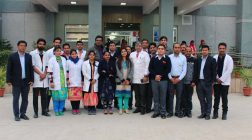Health Insurance Penetrance & Increase in the Healthcare Spending from 1.2 % to 5 % are Key to India’s Healthcare Reforms – Dr Sandeep Chatrath, CEO, Dharamshila Hospital & Research Centre
Health Insurance Penetrance & Increase in the Healthcare Spending from 1.2 % to 5 % are Key to India’s Healthcare Reforms – Dr Sandeep Chatrath, CEO, Dharamshila Hospital & Research Centre
5th Annual India Leadership Conclave 2014 raises the Debate on “Unequal India And Unfinished Agenda Of India’s Health Care Challenges”. Dharamshila Hospital & Research Centre ,the only cancer hospital of India accredited by NABH Awarded at ILC 2014
India debated the most compelling issue on Healthcare Challenges in india at the 5th Annual India Leadership Conclave & Indian Affairs Business Leadership Awards 2014 by Network 7 Media Group’s ( www.network7mediagroup.in ) Indian Affairs Media outfit (www.indianaffairs.tv ), Asia’s biggest analytical news media hosted the much awaited annual affair in its 5th year, the 5th Annual India Leadership Conclave & Indian Affairs Business Leadership Awards 2014 ( www.ilc2014.in )in the commercial capital of india in Mumbai on Friday, 18th July 2014 under a powerful theme on “Perform or Perish” debated, analyzed & addressed by Asia’s most promising voices & industry stalwarts on a variety of subjects ranging from politics to cultural, economics to social. After being highly successful in last 4 editions, the much awaited India Leadership Conclave 2014 was attended by more than 300 business tycoons, political leaders, policy makers, social reformers, diplomats, media professionals. Dr Sandeep Chatrath, CEO, Dharamshila Hospital & Research Centre expressed deep concern on the status of the neglected healthcare scenario in the country today as he said “ India is among the five countries that spends the least on public health. Overall, we spend a meager percent of our GDP on health. To Increase Spending On Healthcare from 1.2% GDP to 5%”
Indian Affairs also recognized & felicitated the ILC Power Brand, Indian of the Year Awards & 30 more categories in various sectors to recognize the shining stars of Indian leaders & companies who has demonstrated rare display of marching ahead with a hostile economy. Dr Sandeep Chatrath, CEO, Dharamshila Hospital & Research Centre. Received the coveted CEO of the Year Healthcare 2014 for the remarkable display of Healthcare Management in today’s complex business of running a specialty Hospitals & Dharamshila Hospital & Research Centre was voted by the Network 7 Jury as India’s Most Valuable & Promising Healthcare Chain 2014 at the Asia’s biggest Leadership Conclave. The prestigious & coveted Awards were presented in a glittering award ceremony with a full house power packed audience to felicitate & honour the Leaders who made india proud, each time they performed in their field, Indian Affairs watched them closely & did not let it pass as their name appeared as top contenders & were put to public votings & were declared winner on the award night on Friday 18th july 2014. Legendary Bollywood Actor Mr. Shakti Kapoor, Dr. Mukesh Batra, India’s most-renowned homeopath & Padma Shri Awardee & Mr Satya Brahma, Chairman & Editor-In-Chief of Network 7 Media Group presented the Awards to the successful Enterprises & Individuals in their respective areas.
The Critical Highlights by Dr Sandeep Chatrath, CEO, Dharamshila Hospital & Research Centre.
PUBLIC–PRIVATE PARTNERSHIP
INADEQUATE NUMBER OF PRIVATE HEALTHCARE PROVIDERS IN RURAL AREAS
ü Concentration in select economically well-off locations
ü Aligning public hospitals with the cashless network
ü Better reach
ü Financially enabling the health infrastructure to upgrade
ü The PPP model aims at bringing quality and affordable healthcare, enlarge the reach and expand the services offered by public healthcare institutions across the country.
HEALTH INSURANCE
To Make Health care affordable HEALTH INSURANCE PENETRATION MUST INCREASE
Lack of health insurance and its low penetration causes further challenge towards access to healthcare. With 75 percent of the Indian population paying for healthcare services from their own pockets, it puts tremendous financial burden.”
REGIONALIZATION CAN BE ADDRESSED BY IMPROVING ACCESS AND EQUITY
- To improve primary healthcare, sub-centres, the first health post for the community.
- In addition to this, district hospitals too should be strengthened to provide high quality secondary care, some elements of essential tertiary care, and training to different categories of healthcare providers.
- Adopting PPP for having more hospitals in tier 2 & 3 cities.
- To provide essential medicines and diagnostics free of cost at all public facilities.
- To strengthen regulatory systems: from hospital accreditation to health professional education and from drug licensing to mandatory adoption of standard management guidelines for diagnosis and treatment of different disease conditions at each level of healthcare.
LITIGATION RATES ARE BOUND TO INCREASE SO HEALTH INDEMNITY IS VERY IMPORTANT FOR DOCTORS & INCREASE PATIENT SAFETY AND IMPROVE HEALTH CARE QUALITY
To follow six International Patient Safety Goals & the Strategies for quality improvement:-
ü Continuous Audit
ü Continuous feedback
ü Continuous Training
Tools for quality improvement:-
ü Failure Modes and Effects Analysis (FMEA)
ü Plan Do Study Act (PDSA)
ü Six Sigma Lean
ü Root Cause Analysis (RCA)
ROLE OF ACCREDITATION IN
HOSPITAL
JCI – 19
NABH – 221
NABL – 67
Key For Furthur Growth
- Prevention Is Better Then Cure
Focus On Preventive Health Checkup
Adopting Healthy Lifestyle
Noncommunicable Diseases Control -Hypertention,Diabettis,Cancer - Focus On Technology Up Gradation
(Eg. Ct Angiography)Shortage Of Specialist & Superspecialist
U.S Under Graduate 19000
& Post Graduate 32000India Under Graduate 50000
&Post Graduate 14000. - Medical Tourism
- 1/5th Cost Advantage In Getting High End Surgery In Our Country.
WELCOME GIRL CHILD
Gender bias in India
ü Gender bias in Schooling
ü Gender bias Immunization
ü Gender bias in treatment seeking
ü Gender bias Nutrition
The Goal Should be ‘INCREASE GENDER EQUALITY AND EMPOWER WOMEN’
“GENDER SENSITIZATION”
The Background of India’s Healthcare Scenario
India has been awarded a ‘Polio Free’ status by way of an official certification presented by the World Health Organisation (WHO). India is among other countries in the South East Asian region which have been certified as being free of the polio virus. India has been polio free since January 2011, as per Mr Ghulam Nabi Azad, Minister for Health and Family Welfare, Government of India.
Healthcare in India today provides existing and new players with a unique opportunity to achieve innovation, differentiation and profits. In the next decade, increasing consumer awareness and demand for better facilities will redefine the country’s second largest service sector employer.
India’s primary competitive advantage over its peers lies in its large pool of well-trained medical professionals. Also, India’s cost advantage compared to peers in Asia and Western countries is significant — cost of surgery in India is one-tenth of that in the US or Western Europe.
In India, the diagnostics sector has been witnessing immense progress in innovative competencies and credibility. Technological advancements and higher efficiency systems are taking the market to new heights. The RNCOS report, ‘Indian Diagnostic Market Outlook to 2015’, highlights that the IVD equipment market will grow at a compound annual growth rate (CAGR) of around 15 per cent from 2012 to 2015.
Market Size
The healthcare sector in India is expected to grow at a CAGR of 15 per cent to touch US$ 158.2 billion in 2017 from US$ 78.6 billion in 2012, according to a report by Equentis Capital.
India being a country with a growing population, its per capita healthcare expenditure has increased at a CAGR of 10.3 per cent from US$ 43.1 in 2008 to US$ 57.9 in 2011, and going forward it is expected to reach US$ 88.7 by 2015.
The factors behind the growth of the sector are rising incomes, easier access to high-quality healthcare facilities and greater awareness of personal health and hygiene.
Healthcare providers in India are expected to spend US$ 1.08 billion on IT products and services in 2014, a four per cent increase over 2013.
Investments
The private sector has emerged as a vibrant force in India’s healthcare industry, lending it both national and international repute. The sector’s share in healthcare delivery is expected to increase from 66 per cent in 2005 to 81 per cent by 2015. The private sector’s share in hospitals and hospital beds is estimated at 74 per cent and 40 per cent, respectively.
According to data released by the Department of Industrial Policy and Promotion (DIPP), hospital and diagnostic centres attracted foreign direct investment (FDI) worth Rs 11,272.32 crore (US$ 1.87 billion) between April 2000 and February 2014.
Some of the major investments in the Indian healthcare industry are as follows:
- Jaypee Group plans to diversify into healthcare by investing in excess of Rs 2,000 crore (US$ 332.68 million) over the next 3–4 years to set up a hospital chain with a minimum capacity of 3,000 beds.
- Helion Venture Partners has invested Rs 27 crore (US$ 4.49 million) in multi-specialty dental care chain Denty’s, as demand for quality patient care increases rapidly in India.
- Medwell Ventures Pvt Ltd has acquired Bengaluru-based Nightingales Home Health Services, which has more than 5,000 families subscribing to its annual care plans. The company expects to establish a network in 10 Indian metro clusters serving over a million families in the coming years.
- Strand Life Sciences has partnered with the Mazumdar-Shaw Medical Foundation (MSMF) to set up a lab that aims to bring down the cost of detecting cancer.
- GE Healthcare and Cancer Treatment Services International have announced plans to launch 25 cancer detection and treatment centres all over India with an investment of Rs 720 crore (US$ 119.77 million) in the next five years.
- ChrysCapital has invested around US$ 40 million in Torrent Pharma, expanding its portfolio of healthcare companies and taking up the total exposure in the sector to nearly US$ 300 million.
Government Initiatives
The Planning Commission has allocated US$ 55 billion under the 12th Five-Year Plan to the Ministry of Health and Family Welfare, which is about three times the actual expenditure under the 11th Five-Year Plan. The 12th Plan focuses on providing universal healthcare, strengthening healthcare infrastructure, promoting research and development (R&D) and enacting strong regulations for the healthcare sector.
Some of the major initiatives taken by the government to promote the healthcare sector in India are as follows:
- All India Institute of Medical Sciences (AIIMS) spends at least Rs 2 million (US$ 33,271.51) annually on each faculty member, according to a study by the institute’s hospital administration.
- Sikkim has become India’s first state with 100 per cent sanitation coverage, according to a report of the drinking water and sanitation ministry. “The state has also sensitised people to adopt a holistic approach to improve sanitation and hygiene for a clean environment while accelerating overall development in the state,” according to the Government of Sikkim.
- India and Maldives have signed three agreements after delegation level talks between Mr Abdulla Yameen Abdul Gayoom, President, Maldives, and Dr Manmohan Singh, Prime Minister of India, on January 2, 2014. The pacts include a Memorandum of Understanding (MoU) on health cooperation.
- The Union Cabinet has approved the proposal for setting up of National Cancer Institute (NCI) at a cost of Rs 2,035 crore (US$ 338.51 million). NCI will be set up in the Jhajjar campus (Haryana) of All India Institute of Medical Sciences (AIIMS), New Delhi. The project is estimated to be completed in 45 months.
- Mr Sis Ram Ola, Union Minister of Labour and Employment, Government of India, has inaugurated the state-of-the-art ESIC Model Hospital at Jaipur, Rajasthan.
Road Ahead
Telemedicine is a fast emerging sector in India. In 2012, the telemedicine market in India was valued at US$ 7.5 million, and is expected to grow at a CAGR of 20 per cent to US$ 18.7 million by 2017.
India’s competitive advantage also lies in the increased success rate of Indian companies in getting Abbreviated New Drug Application (ANDA) approvals. India also offers vast opportunities in R&D as well as medical tourism.
The Indian medical tourism industry is pegged at US$ 1 billion per annum, growing at around 18 per cent and is expected to touch US$ 2 billion by 2015.
There is a significant scope for enhancing healthcare services considering that healthcare spending as a percentage of GDP is rising. Rural India, which accounts for over 70 per cent of the population, is set to emerge as a potential demand source. Only three per cent of specialist physicians cater to rural demand.There are vast opportunities for investment in healthcare infrastructure in both urban and rural India. About 1.8 million beds are required by the end of 2025. Additionally, 1.54 million doctors and 2.4 million nurses are required to meet the growing demand.
Exchange Rate: INR 1 = US$ 0.0166 as on June 27, 2014
In India, healthcare sector suffers from underfunding and bad governance. Yes, India has made huge improvements since independence. But majority (70%) of the effort has been private sector led. Still India accounts for 21% of the world’s burden of disease.
In fact India has increased spending over the years. Also, the government plans to increase it even further nearly by 2.5% of the GDP in the 12th five year plan. The amount of public fund that India invests in health care is very small compared to other emerging economies. With 6% of GDP expenditure on Healthcare, India ranks among the bottom five countries with the lowest public health spending globally.
India needs the importance of shifting from ‘infrastructure focus’ to ‘productivity focus’ to generate corresponding improvements in India’s healthcare access. This can only be achieved if larger fund allocation for healthcare is accompanied by effective and innovative interventions to improve the existing healthcare ecosystem in order to achieve global standards”
The report points three major challenges hampering the growth of the healthcare sector and therefore the delivery of healthcare services:
Substantial gaps in healthcare infrastructure
Hospital bed density in India has stagnated at 0.9 per 1000 population since 2005 and falls significantly short of WHO laid guidelines of 3.511 per 1000 patients’ population. Moreover, there is a huge inequity in utilization of facilities at the village, district and state levels with state level facilities remaining the most strained.
Low healthcare insurance service coverage
This leads to high levels of out of pocket spending: Nearly 80% of spend in India is out-of pocket, primarily due to with extremely limited insurance coverage, both personal and government funded. Research has shown that the proportion of medical and healthcare expenditure in overall personal consumption has risen considerably over the years.
Medical manpower remains inadequate
India is currently known to have approximately 600,000 doctors and 1.6 mn nurses. This translates into one doctor for every 1,800 people. The recommended WHO guidelines suggest that there should be 1 doctor for every 600 people. This translates into a resource gap of approximately 1.4 mn doctors and 2.8 mn nurses. There is also a clear disparity in the man power present in the rural and urban areas.
Krishna Giri also added, “Comprehensive adoption of Information Technology and digitization of systems to improve access to these services is central to the success of these projects”.
The report proposes five key measures that Accenture believes will have the most significant impact on improving healthcare access in India:
- Implementing (HIS) Hospital Information Systems and record-digitization to improve delivery of healthcare services to the public.
- Automating supply chain management is the cornerstone of all successful healthcare systems.
- Empowering Citizens through Information Dissemination.
- Collecting data via handheld mobile devices, given the limitations of providing hard IT infrastructure in the vast reaches of rural India.
- Analytics-enabled real time disease surveillance, with real time surveillance costs, and ‘time-to-reaction’ are significantly lowered, leading to not only economic savings, but a much more efficient outbreak intervention mechanism as well.
These recommendations can address several inefficiencies in the healthcare value chain in India, and provide increased healthcare access to citizens, without significantly increasing the spending on the same.











